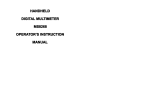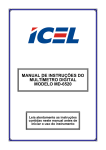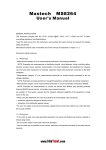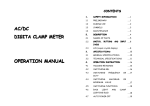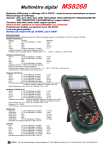Download Mastech MS8268 Instruction manual
Transcript
Mastech MS8268 HANDHELD DIGITAL MULTIMETER OPERATOR’S INSTRUCTION MANUAL http://www.chargerbuy.com Table of Contents TITLE Table of Contents PAGE 1. GENERAL INSTRUCTIONS 1.1 Precaution safety measures 1.1.1 Preliminary 1.1.2 During use 1.1.3 Symbols 1.1.4 Instructions 1.2 Safety mechanisms 1 1 1 2 4 4 5 2. DESCRIPTION 6 2.1 Instrument Familiarization 2.2 LCD Display 2.3 Keypad 2.4 Terminals 6 7 9 10 2.5 Rotary switch 2.6 Accessories 11 11 3. FUNCTION DESCRIPTION 12 3.1 General Functions 3.1.1 Misconnection alarm system 3.1.2 DATA HOLD mode 3.1.3 Manual ranging and Autorange mode 3.1.4 Battery Saver 3.1.5 Relative measurement mode 3.2 Measurement Functions 3.2.1 AC and DC Voltage measurement 12 12 13 13 14 14 15 15 Ⅰ PAGE TITLE 3.2.2 Resistance measurement 16 3.2.3 Diode Test 17 3.2.4 Continuity Check 18 3.2.5 Transistor measurement 18 3.2.6 Capacitance measurement 19 3.2.7 Frequency and Duty Cycle measurement 20 3.2.8 Current measurement 22 4. TECHNICAL SPECIFICATIONS 23 4.1 GENERAL SPECIFICATIONS 4.2 Measurement specifications 4.2.1 DC Voltage 4.2.2 AC Voltage 4.2.3 Resistance 4.2.4 Audible continuity 4.2.5 Diode 4.2.6 Transistor 4.2.7 Capacitance 4.2.8 Frequency 4.2.9 DC CURRENT 4.2.10 AC CURRENT 23 24 24 25 25 25 26 26 26 26 28 28 5. MAINTENANCE 29 5.1 General Maintenance 5.2 Fuse replacement 5.3 Battery replacement 29 29 30 Ⅱ 1. GENERAL INSTRUCTIONS This instrument complies with IEC 1010-1 (61010-1@IEC: 2001), CAT. II 1000V and CAT. III 600V overvoltage standards. See Specifications. To get the best service from this instrument, read carefully this user's manual and respect the detailed safety precautions. International symbols used on the Meter and in this manual are explained in chapter 1.1.3 1.1 Precautions safety measures 1.1.1 Preliminary * Measurement category III is for measurements performed in the building installation. NOTE: Examples are measurements on distribution boards, circuit-breakers, wiring, including cables, bus-bars, junction boxes, switches, socket-outlets in the fixed installation, and equipment for industrial use and some other equipment, for example, stationary motors with permanent connection to the fixed installation. * Measurement category II is for measurements performed on circuits directly connected to the low voltage installation. NOTE: Examples are measurements on household appliances, portable tools and similar equipment. * Measurement category I is for measurements performed on circuits not directly connected to MAINS. NOTE: Examples are measurements on circuits not derived from MAINS, and specially protected (internal) MAINS derived circuits. In the latter case, transient stresses are variable; for that reason, requires that the transient withstand capability of the equipment is made known to the user. 1 * When using this Multimeter, the user must observe all normal safety rules concerning: ― Protection against the dangers of electric current. ― Protection of the Multimeter against misuse. * For your own safety, only use the test probes supplied with the instrument. Before use, Check that they are in good condition. 1.1.2 During use * If the meter is used near noise generating equipment, be aware that display may become unstable or indicate large errors. * Do not use the meter or test leads if they look damaged. * Use the meter only as specified in this manual; otherwise, the protection provided by the meter may be impaired. * Use extreme caution when working around bare conductors or bus bars. * Do not operate the meter around explosive gas, vapor, or dust. * Verify a Meter's operation by measuring a known voltage. Do not use the Meter if it operates abnormally. Protection may be impaired. When in doubt, have the Meter serviced. * Uses the proper terminals, function, and range for your measurements. * When the range of the value to be measured is unknown, check that the range initially set on the multimeter is the highest possible or, wherever possible, choose the autoranging mode. * To avoid damages to the instrument, do not exceed the maximum limits of the input values shown in the technical specification tables. * When the multimeter is linked to measurement circuits, do not touch unused terminals. 2 * Do not apply any voltage measurement between the 10A terminal and the COM terminal. * Caution when working with voltages above 60Vdc or 30Vac rms. Such voltages pose a shock hazard. * When using the probes, keep your fingers behind the finger guards. * When making connections, connect the common test lead before connecting the live test lead; when disconnecting, disconnect the live test lead before disconnecting the common test lead. * Before changing functions, disconnect the test leads from the circuit under test. * For all dc functions, including manual or auto-ranging, to avoid the risk of shock due to possible improper reading, verify the presence of any ac voltages by first using the ac function. Then select a dc voltage range equal to or greater than the ac range. * Disconnect circuits power and discharge all high-voltage capacitors before testing resistance, continuity, diodes, or capacitance. * Before measuring current, check the meter's fuse and turn off power to the circuit before connecting the meter to the circuit. * Never perform resistance or continuity measurements on live circuits. * In TV repair work, or when carrying out measurements on power switching circuits, remember that high amplitude voltage pulses at the test points can damage the multimeter. Use of a TV filter will attenuate any such pulses. * Use three 1.5V AAA batteries, properly installed in the Meter's battery case, to power the Meter. 3 * Replace the batteries as soon as the battery indicator ( ) appears. With a low battery, the Meter might produce false readings that can lead to electric shock and personal injury. * Do not measure voltages above 600V in Category III, or 1000V in Category II installations. 1.1.3 Symbols: Symbols used in this manual and on the instrument: Caution: refer to the instruction manual. Incorrect use may result in damage to the device or its components. Dangerous voltage may be present. ~ AC (Alternating Current) DC (Direct Current) AC or DC Earth ground Double insulated Fuse Conforms to European Union directives 1.1.4 Instructions * Remove test leads from the Meter before opening the Meter case or battery cover. * When servicing the Meter, use only specified replacement parts. * Before opening up the instrument, always disconnect from all sources of electric current and make sure you are not charged with static electricity, which may destroy internal components. 4 * Any adjustment, maintenance or repair work carried out on the meter while it is live should be carried out only by 2. DESCRIPTION 2.1 Instrument Familiarization appropriately qualified personnel, after having taken into account the instructions in this present manual. * A "qualified person" is someone who is familiar with the installation, construction and operation of the equipment and the hazards involved. He is trained and authorized to energize and de-energize circuits and equipment in accordance with established practices. AC * When the instrument is opened up, remember that some internal capacitors can retain a dangerous potential even after the instrument is switched off. * If any faults or abnormalities are observed, take the instrument out of service and ensure that it cannot be used until it has been checked out. * If the meter is not going to be used for a long time, take out the battery and do not store the meter in high temperature or high humidity environment. 1.2 Safety mechanisms * Misconnection alarm system * If the maximum range is repeatedly exceeded, a continuous audible signal warns the user in DCV, ACV, DCμA, ACμA, DC mA, AC mA, DC 10A and AC 10A functions. 1. LCD display 2. Keypad 5 3. Rotary switch 6 4. Terminals 2.2 LCD Display See Table 1 indicated for information about the LCD display. Symbol Table 1. Display Symbols (continued) Meaning RELΔ Indicator for the Relative measurement. Indicator for the Diode Test mode hFE Indicator for the transistor test mode Indicator for the Continuity Check mode. Indicator for the Data Hold mode AC V, mV Volts. The unit of voltage. Millivolt. 1x10-3 or 0.001 volts. Meaning A, mA, μA The battery is low. Warning: To avoid false readings, which could lead to possible electric shock or personal injury, replace the battery as soon as the battery indicator appears. A: Amperes (amps). The unit of current. mA: Milliamp. 1x10-3 or 0.001 amperes. μA: Microamp. 1x10-6 or 0.000001 amperes Ω, kΩ, MΩ Ω: Ohm. The unit of resistance. kΩ: Kilohm. 1x103 or 1000 ohms. MΩ: Megohm. 1x106 or 1,000,000 ohms. Table 1. Display Symbols Symbol Indicates negative readings. Indicator for ac voltage or current. AC voltage and current are displayed as the average of the absolute value of the input, calibrated to indicate the equivalent rms value of a sine wave. Indicator for dc voltage or current. AUTO V: mV: The Meter is in the Autorange mode in which the meter automatically selects the range with the best resolution. 7 Hz: Hz, kHz, MHz Hertz. The unit of frequency in cycles/second. KHz: Kilohertz. 1x103 or 1000 hertz. MHz: Megahertz. 1x106 or 1,000,000 hertz. μF, nF F: Farad. The unit of capacitance. μF: Microfarad.1x10-6 or 0.000001 farads. nF: Nanofarad. 1x10-9 or 0.000000001 farads. % %: Percent. The unit of Duty cycle. The input is too large for the selected range. 8 2.3 Keypad See Table 2 indicated for information about the keypad operations. Table 2. Keypad Key RANGE Function V~,V ,Ω, mA and μA A, mA and μA V~, A, and μA. HOLD Any switch Press HOLD to enter and exit position 1. Press RANGE to enter the manual ranging mode. 2. Press RANGE to step through the ranges available for the selected function. 3. Press and hold RANGE for 2 seconds to return to autoranging. LIGHT mA Table 4. Terminals Terminal Description Return terminal for all measurements. COM (Receiving the black test lead or the “com” plug of the special multi-function socket) Input for voltage, resistance, capacitance, frequency, Press REL to enter and exit the Relative measurement mode. 9 Press to turn the backlight on. The backlight will be auto-off about 5 seconds later. See Table 4 indicated for information about the terminals. Switches between dc and ac current. 1 Press to start the frequency counter. 2 Press again to enter duty cycle (duty factor) mode. 3 Press again to exit the frequency counter mode. Any switch position the Data Hold mode. 2.4 Terminals VΩHz Any switch position Hz/ % Operation performed Disables automatic power-off feature. Power-up Option REL Function Operation performed Switches between Diode Test and Continuity check. SELECT Table 2. Keypad(continued) Key diode and continuity measurements. (Receiving the red test lead or the “+” plug of the special multi-function socket). Input for hFE and 0.001mA to 400mA hFE μA current measurements. (Receiving the red mA test lead or the “+” plug of the special multi-function socket) 10A Input for 400mA to 10A current measurements. (Receiving the red test lead). 10 2.5 Rotary switch A eleven-position rotary selector switch gives access to the following quantities: ¥ Current: 10A ¥ Current: mA ¥ Current: μA ¥ DC Voltage ¥ AC Voltage ¥ OFF: off position ¥ Resistance ¥ Diode and Continuity (with beep) ¥ Capacitance ¥ Transistor: hFE ¥ Frequency 3. FUNCTION DESCRIPTION 3.1 General Functions 3.1.1 Misconnection alarm system The input terminals of the meter are equipped with sound and light alarms against misconnection of test leads. At V, Ω, and ranges: 1 The red lights at the “V” and “COM” terminals will be off after the test leads are plugged in. 2 The buzzer will sound upon misconnection of the test leads in the “mA” or “10A” terminals to warn the user. At the same time, the lights at the “V” and “COM” terminals will flash to remind the user to plug in the test leads there. At μA, mA, and hFE ranges: 2.6 Accessories 1 The red lights at the “mA” and “COM” terminals will be Delivered with the multimeter: ¥ User's manual off after the test leads are plugged in. 2 The buzzer will sound upon misconnection of the test ¥ Test leads leads in the “V” or “10A” terminals to warn the user. At ¥ Special Multi-function socket the same time, the red lights at the “mA” and “COM” terminals will flash to remind the user to plug in the test leads there. At A range: 1 The red lights at the “10A” and “COM” terminals will be off after the test leads are plugged in. 2 The buzzer will sound upon misconnection of the test leads in the “V” or “mA” terminals to warn the user. At the same time, the lights at the “10A” and “COM” terminals will flash to remind the user to plug in the test leads there. 11 12 3.1.2 DATA HOLD mode Data Hold mode makes the meter stop updating the display. Enabling Data Hold function in autorange mode makes the meter switch to Manual ranging mode, but the full-scale range remains the same. Data Hold function can be cancelled by changing the measurement mode, pressing RANGE key, or push HOLD key again. To enter and exit the Data Hold mode: 1. Press HOLD key (short press). Fixes the display on the current value, “H” is displayed. 2. A second short press returns the meter to normal mode. 3.1.3 Manual ranging and Autorange mode The Meter has both manual ranging and autorange options. * In the autorange mode, the Meter selects the best range for the input detected. This allows you to switch test points without having to reset the range. * In the manual ranging mode, you select the range. This allows you to override autorange and lock the meter in a specific range. * The Meter defaults to the autorange mode in measurement functions that have more than one range. When the Meter is in the autorange mode, AUTO is displayed. To enter and exit the manual range mode: 1. Press RANGE key. The Meter enters the manual ranging mode. AUTO turns off. Each presses of RANGE key increments the range. When the highest range is reached, the Meter wraps to the lowest range. 13 NOTE: If you manually change the measurement range after entering the Data Hold modes, the Meter exits this mode. 2. To exit the manual ranging mode, press and hold down RANGE key for two seconds. The Meter returns to the autorange mode and AUTO is displayed. 3.1.4 Battery Saver The Meter enters the "sleep mode" and blanks the display if the Meter is on but not used for 15 minutes. Press the HOLD key or rotate the rotary switch to wake the meter up. To disable the Sleep mode, hold down the SELECT key while turning the meter on. One minute before power off, the beeper will sound 5 sounds. The beeper will sound again before power off. 3.1.5 Relative measurement mode The Meter will display relative measurement in all functions except frequency. To enter and exit the relative measurement mode: 1. With the Meter in the desired function, touch the test leads to the circuit on which you want future measurement to be based. 2. Press REL key to store the measured value and activate the relative measurement mode. The difference between the reference value and subsequent reading is displayed. 3. Press REL key for more than 2 seconds to return the Meter to normal operation. 14










